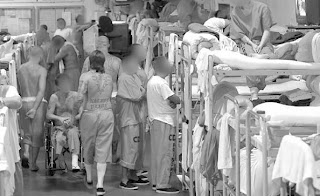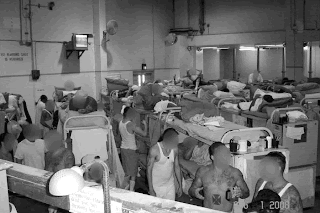Susan Sontag claims, “Photographs cannot create a moral position, but they can reinforce one-and can help build a nascent one.”[1]
Perhaps the most recent challenge to this assumption are the photographs released in the Supreme Court case of Brown v. Plata, in which Justice Kennedy released three black and white images that depict the over crowding population problem facing California prisons. The first two photographs show the barrack like conditions for inmates who now live in the prison’s gymnasium. The third image is rather disturbing as it displays the holding cells for inmates who await treatment for mental illness problems. The holding cells do not seem to be much larger than a high school locker.
Briefly, here are the facts of the case. In 1990, Coleman v. Brown challenged the ability of California prisons to offer adequate healthcare for inmates with serious mental health issues. The California prison system was initially designed to hold a capacity of 80,000 prisoners. In 2005, authorities estimated the California prison population to be over 142,000. At that time, the Federal Court of California argued that one prisoner dies every 6-7 days due to problem of insufficient health conditions. In 2011, the Supreme Court ruled in a 5-4 decision that California prisons needed to release approximately 33,000 inmates.
In his opinion, Justice Kennedy highlighted the serious constitutional issue of “cruel and unusual punishment” and to support his argument, he included three black and white photos that depict the serious and potentially deadly prison conditions.
The inclusion of images within legal discourse is not a groundbreaking practice, however, it does raise an ethical question concerning the relationship and intersection of visual culture and American law. One viewpoint on the subject is that photographs do not belong in legal decisions. Hampton Dillinger highlights several potential dangers from the use of photographs in legal decisions. According to Dellinger, “Visual attachments are much more likely to obscure the best available legal answer rather than reveal it.”[2] Dellinger has three main arguments on why images should not be included in legal decisions. First, visual attachments appear to possess neutral and objective qualities. Second, visual attachments might appear to audiences as “accurate” and “credible” representations of reality. Third, visual attachments operate as “communicative vehicles of economy,” which contains an impact more powerful than words. Moreover, Dellinger argues the use of imagery in judicial decisions can help Justices “resolve a difficult legal point too easily by distracting the reader with an eye-catching attachment.”
Is this the case with Brown v. Plata?
Did Justice Kennedy distract readers from the important constitutional violation of the 8th Amendment for inmates in California prisons? I think so.
Justice Kennedy has done more justice with three photographs than in 91 pages of written judicial opinion. These images are not a substitution for moral action rather they are the production of morality. The photographs are eye-catching images that may overlook the best possible legal decisions concerning the problem of overpopulation in California prisons. Moreover, the photographs attempt to resolve a complex legal problem concerning the power of the Supreme Court to regulate State prisons.
More importantly, the photographs ask audiences to create a moral position through a visual form of emotional legal reasoning. Photographs can be thought of as an avenue that defines the relationship between citizens and the state. It is not uncommon to think of these images to challenge society on a variety of social, political, and economic issues. The Brown v. Plata photographs encourage the audience to feel a sense of compassion and empathy for the prisoners. In this sense, the photographs do not create a moral position, but help reinforce the belief that American justice does not tolerate “cruel and unusual punishment.”
[2] For more information, see Hampton Dellinger, “Words Are Enough: The Troublesome Use of Photographs, Maps, and Other Images in Supreme Court Opinions” Harvard Law Review 110, no. 8 (1997): 1704-1753.
[1] See Susan Sontag, On Photography (New York: Anchor Books, [1977] 1990).



Are the photographs moral or empirical? I think it would be interesting to look at how they are used in the legal argument as "scientific" evidence in the positivist sense, although I'd have to read the original case in order to determine one way or another which sense is the more accurate.
ReplyDelete